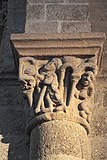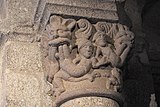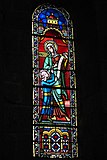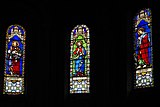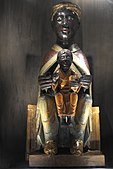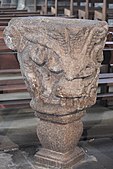St-André-St-Léger (Meymac)
The Catholic Church of Saint-André-Saint-Léger in Meymac , a parish in the Corrèze department in the French region of Nouvelle-Aquitaine , was built in the Romanesque style in several phases from the 11th century . The church is consecrated to the apostle Andrew and, as the second patron, to St. Leodegar of Autun . In 1840 the church was added to the list of architectural monuments in France as a monument historique .
history
Two documents from 1085 show that Archambaud III, Vice Count of Comborn , founded a monastery in Meymac that year and that he subordinated it, including the church of Meymac, to the Benedictine abbey of Uzerche . The church was used as both a parish and a monastery church. At the beginning of the 12th century the monastery came into the possession of relics (head and hand) of St. Leodegar von Autun and Meymac developed into a place of pilgrimage . Around 1146 the monastery broke its dependence on Uzerche and was elevated to the status of an abbey itself. As a result of the conflict between the House of Plantagenet and the French king, the abbey's situation deteriorated in the 13th century. In the 14./15. In the 19th century, during the Hundred Years War , the monastery buildings were looted and set on fire. In 1633 only one monk lived in the abbey. 1669 reform order who took Maurists the monastery and let new convent building. During the French Revolution the monastery was closed and in 1791 the last five monks had to leave the monastery. The buildings were used as barracks, barn and horse stable, and in the second half of the 19th century the school, post office, tourist office and the Marius Vazeilles museum were established here. Since the renovation in the 1980s, the former monastery buildings have housed the Marius Vazeilles Museum and a center for contemporary art.
architecture
Exterior construction
The church, built over a Latin cross in granite , is 50 meters long. The vestibule under the bell tower on the west facade is the oldest part of the church. It probably goes back to the 11th century and was probably created before the monastery was founded. Three portals are cut into the west facade of the vestibule, the middle portal is framed by a jagged arch and slightly pointed archivolts . Three slightly tapered windows open above it. The square bell tower was rebuilt in the 17th century.
inner space
The three-aisled vestibule in the base of the bell tower is vaulted by a dome. The two side aisles are not open to the interior of the church. The single nave nave , which was probably added to the vestibule at the end of the 12th century, extends over two bays and is covered by ribbed vaults. Both arms of the transept open into semicircular apses , each of which is illuminated by three windows. The choir is three steps higher and also closes with an apse with five windows cut into it.
Capitals
Scabbard and belt arches rest on massive pillars with pillars, which are designed with plant motifs and sculpted capitals . Lions and winged monsters can be seen on the capitals, naked human figures are devoured by monsters.
Leaded glass window
The leaded glass windows in the choir show the year 1861 and the signature of Émile Thibaud. They represent Jesus in the middle, the Apostle Peter on the left and the Evangelist John on the right . Three windows were made by Félix Gaudin in Clermont-Ferrand in 1885 . They depict the patron saint of the church, Leodegar von Autun, the instruction of Mary and Saint Joachim . Other windows date from 1940 and are the work of the glass painter Francis Chigot from Limoges . A window from 1984 bears Dominique de Raed's signature.
Furnishing
- The church has a black Madonna from the 12th century. A copy is on display in a showcase in the choir. Our Lady sits on a throne without a backrest. The baby Jesus is sitting on her lap, holding a book in her left hand. The figures are carved from very dark wood, their clothing is colored and partially gilded.
- A figuratively carved capital from the 12th century is used as a holy water font.
literature
- Erich Grau, Margit Kilian: The Limousin . DuMont Buchverlag, Cologne 1992, ISBN 3-7701-2732-3 , p. 214.
- Limousin . Hachette, Guides Bleus, Paris 1997, ISBN 2-01-242306-X , p. 363.
Web links
- René Fage: L'Église de Meymac BNF Gallica, pp. 69-89.
- Abbaye de Meymac Center de la Culture du Limousin Médiéval (French and English text, accessed December 13, 2018)
- Autours de l'Abbaye Videoguide Nouvelle Aquitaine, Conseil régional d'Aquitaine Limousin Poitou-Charentes (French and English text, accessed December 13, 2018)
- Abbaye Saint-André de Meymac Abbayes et Prieurés Mauristes (French text, accessed December 13, 2018)
Individual evidence
- ↑ Église abbatiale Saint-André et Saint-Léger in the Base Mérimée of the French Ministry of Culture (French)
- ↑ Vierge noire in the Base Palissy of the French Ministry of Culture (French)
- ↑ Chapiteau transformé en bénitier in the Base Palissy of the French Ministry of Culture (French)
Coordinates: 45 ° 31 '54.1 " N , 2 ° 8' 52.8" E



